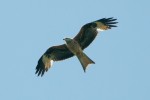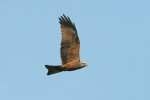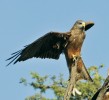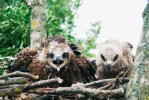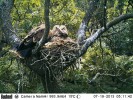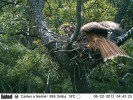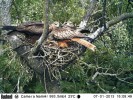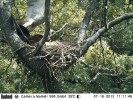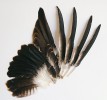Luňáci rodu Milvus jsou v současné době objektem studia ornitologických taxonomů (v současnosti se rozlišují čtyři druhy), věnuje se jim pozornost z hlediska evoluční historie, udivováni jsme poznatky z jejich sociálního života a velké úsilí je zaměřeno na jejich ochranu. Překvapivě početné jsou případy mezidruhové hybridizace mezi sympatricky (na stejném území) se vyskytujícími luňáky červenými (M. milvus) a luňáky hnědými (M. migrans). V článku je přiblížen aktuální pohled na taxonomii luňáků v globálním kontextu a detailně popíšeme průběh hnízdění smíšených párů luňáka červeného a luňáka hnědého, které se nám poprvé v přírodě podařilo zaznamenat v letech 1995 a 1996 na Slovensku a r. 2013 také v České republice.
Pod náhledy obrázků ke stažení pdf soubory s doplňujícími tab. I a II
Citovaná literatura:
Aebischer A. 2009. Distribution and recent population changes of the Red Kite in the Western Palaearctic –results of a recent comprehensive inquiry. Proceedings of the Red Kite International Symposium, October 2009, France, 12-14. (The proceedings are available on http://milan-royal.lpo.fr)
Avibase – the world bird database. 2013. Avibase taxonomic concepts v. 01 (August 2013). (http://avibase.bsc-eoc.org/avibase.jsp?lang=EN, poslední přístup 29. 8. 2013)
Balát F., Kux Z. 1946. Hnízdění luňáka hnědého (Milvus migrans migrans /Bodd./) ve volavčí kolonii na Hodonínsku. Československý ornitholog 13: 8-10.
Berndt R.K., Koop B., Struwe-Juhl B. 2002. Vogelvelt Schleswig-Holsteins, Bd. 5: Brutvogeatlas. Wachholtz, Neumünster.
BirdLife. 2004. BirdLife Conservation Series No. 12. Birds in Europe. Population estimates, trends and conservation status. BirdLife International. 374 pp.
Bijlsma R.B. 1988. Unidentified Kenyan kites – hybrid black × red? GABAR 3: 19-20
Clements J.F. 2007. The Clements checklist of birds of the world, Sixth Edition. Cornell University Press. 843 pp.
Corso A., Forsman D. 1997. Hybrids between Black Kite and Common Buzzard. Alula 1: 44-45.
Corso A., Gildi R. 1998. Hybrids of Black Kite and Common Buzzard in Italy in 1996. Dutch Birding 20: 226-233.
Corso A., Palumbo G. 2001. Prima osservazione italiana di ibrido tra Nibio reale Milvus milvus e Nibio bruno Milvus migrans. Picus 27: 31-33.
Danko Š. 1977. Správa o činnosti skupiny pre výskum dravého vtáctva a sov v Československu za roky 1975 a 1976. Falconiana I (Súbor referátov z celoštátneho seminára “Dravé vtáky – Nitra 1976”), 93-104.
Danko Š., Lešo P., Pjenčák P., Lipták J., Fulín M., Pačenovský S., Mošanský A., Mošanský L., Olejár R., Potočný R., Krištín A., Šimák L., Buday M., Fecko M., Urban L., Imrich P., Balla M., Žigraj J. 2010. Vtáctvo Slanských vrchov a ich predhorí. Slovenská ornitologická slopočnosť/BirdLife Slovensko Bratislava. 252 pp.
Davis P.W., Davis P.E. 1973. The ecology and conservation of the Red Kite in Wales. British Birds 66: 183-224, 241-270.
Naurois R. de. 1987. Les oiseaux de l´archipel du Cap Vert, peuplements, adaptations, endémisme. Bulletin de la Société Zoologique de France 112: 307-326.
Dittberner H, Dittberner W. 2002. Der Rotmilan – ein Greifvogel der Insel Rügen. Rugia-Journal: 81-85.
Dörrie H.H. 2001. Avifaunischer Jahresbericht 2000 für den Raum Göttingen und Nordheim. Naturkundl. Ber. Fauna Süd-Niedersachsen 6: 5-121.
Forsman D., Nye D. 2007. A hybrid Red Kite × Black Kite in Cyprus. Birding World 20: 480-481.
Frere P.J. 1987. Unidentified Milvus Kites in Kenya. GABAR 2: 47-48.
Hazevoet C.J. 1995. The birds of the Cape Verde Islands. Tring, UK: British Ornithologists´Union (Check-list 13).
Hille S.M., Collar N.J. 2009. The taxonomic and conservation status of Milvus kites in the Cape Verde archipelago: further (and final?) reflections. Bulletin of the British Ornithologists´ Club 129: 217-221.
Hille S., Thiollay J.-M. 2000. The imminent extinction of the Kites Milvus milvus fasciicauda and M. m. migrans on the Cape Verde Island. Bird Conservation International 10: 361-369.
Horák P. 2002. Hnízdění luňáka hnědého (Milvus migrans) a luňáka červeného (Milvus milvus) na jižní Moravě v letech 1991-2000. Crex – Zpravodaj Jihomoravské pobočky ČSO 18: 9-20.
Hudec K., Šťastný K. 2005. Fauna ČR. Ptáci 2/I, Academia Praha.
Johnson J.A., Watson R.T., Mindell D.P. 2005. Prioritizing species conservation: does the Cape Verde kite exist? Proceedings of the Royal Society, London B 272: 1365-1371.
Kimball T.R., Parker P.G., Bednarz J.C. 2003. Occurrence and evolution of cooperative breeding among the diurnal raptors (Accipitridae and Falconidae). The Auk 120: 717-729.
Landsfeld B. a koordinátoři. 2013. Odhad počtu párů dravců a vybraných druhů sov v ČR. Zpravodaj Skupiny na ochranu a výzkum dravců a sov 13: 3.
Looft V., Busche, G. 1981. Vogelwelt Schleswig-Holsteins, Greifvögel. Wachholtz, Neumünster.
Maderič B. 2013a. Haja červená (Milvus milvus). Dravce a sovy. Časopis Ochrany dravcov na Slovensku 9: (1), 11.
Maderič B. 2013b. Haja tmavá (Milvus milvus). Dravce a sovy. Časopis Ochrany dravcov na Slovensku 9: (1), 12.
Martiško J., Šťastný K., Bejček V., Hudec K., Pellantová J., Vlašín M. 1994. Hnízdní rozšíření ptáků. Jihomoravský region, část 1. Nepěvci. Moravské zemské muzeum, Český svaz ochránců přírody ZO Palava, Brno. 238 pp.
McCarthy E.M. 2006. Handbook of avian hybrids of the world. Oxford University Press. 583 pp.
Monsén B. 1987. Häcking av Brunglada x Hybridglada i Värmland 1981. Värmlandsornithologen 15: 13-15.
Nachtigal W., Gleichner W., 2005. Mischbruten zwischen Rot- Milvus milvus und Schwarzmilan M. migrans – ein weiterer Fall aus Sachsen. Limicola 19: 180-194.
Ortlieb H. 1995. Der Rotmilan Milvus milvus. 4. Aufgabe. Die Neue Brehm-Bücherei Bd. 532, Westarp Wiessenschaften, Magdeburg. 160 pp.
Ortlieb H. 1998. Der Schwarzmilan Milvus migrans. Die Neue Brehm-Bücherei Bd. 100. Westarp Wiessenschaften, Hohenwarsleben. 176 pp.
Roques S., Negro J.J. 2005. MtDNA genetic diversity and population history of a dwindling raptorial bird, the red kite (Milvus milvus). Biological Conservation 126: 41-50.
Schmidt M., Schmidt R. 2006. Langjährig erfolgreiches Mischbrutpaar von Schwarz- (Milvus migrans) and Rotmilan (Milvus milvus) in Schleswig-Holstein. Corax 20: 165-178.
Schreiber A., Stubbe M., Stubbe A. 2000. Red Kite (Milvus milvus) and black kite (M. migrans): minute genetic interspecies distance of two raptors breeding in a mixed community (Falconiformes: Accipitridae). Biological Journal of the Linnean Society 69: 351-365.
Stübing, S., Fichtler M. 2006. Hybriden zwischen Rot- Milvus milvus und Schwarzmilan M. migrans: Vorkommen, Verwechslungsgefahren und eine neue Beobachtung aus Hessen. Limicola 20: 169-186.
Swensson S. 1979. European news, Black Kite Milvus migrans. British Birds 72: 590.
Sylvén M. 1977. Hybridisering mellan glada Milvus milvus och brun glada M. migrans i Sverige 1976 (Hybridization between Red Kite Milvus milvus and Black Kite M. migrans in Sweden in 1976, in Swedish with English summary). Vår Fågelvärld 36: 38-44.
Šťastný K., Bejček V., Hudec K. 2006. Atlas hnízdního rozšíření ptáků v České republice, 2001-2003. Aventinum Praha. 463 pp.
Wobus U., Creutz G. 1970. Eine erfolgreiche Mischbrut von Rot- und Schwarzmilan (Milvus milvus × Milvus migrans). Zool. Abh. Mus. Tierkd. Dresden 31, 18: 305-313.
Woolley S. 2004. An unusual kite at Cheesefoot Head in early 2003. Hampshire Bird Report, November 2004(2005): 215-219.
At present, four valid species are recognized within the genus Milvus. Red Kites (M. milvus) and Black Kites (M. migrans migrans) occur sympatrically in Slovakia and the Czech Republic. One mixed pair of kites (a Red Kite female and Black Kite male) nested successfully in Slovakia in 1995 and 1996 (with three and two young, respectively). Another mixed pair of kites (a Red Kite female and Black Kite male) nested successfully in the Czech Republic in 2013. Two young fledged from the nest, the third one was killed by a Goshawk (Accipiter gentilis) during the nesting period. These reports represent the first cases of inter-specific hybridization of kites in these two countries. Moreover, an indication of cooperative nesting was observed in the Czech Republic.
 Hybridní mláďata samice luňáka červeného (Milvus milvus) a samce luňáka hnědého (M. migrans) na hnízdě 7. června 2013. Hnízda smíšených párů luňáků s úspěšným vyvedením mláďat byla sledována v letech 1995 a 1996 na Slovensku a v r. 2013 v České republice. Ve sporných případech identifikace luňáků v terénu by se měla zvažovat také možnost pozorování mezidruhových hybridů. Foto H. Matušík
Hybridní mláďata samice luňáka červeného (Milvus milvus) a samce luňáka hnědého (M. migrans) na hnízdě 7. června 2013. Hnízda smíšených párů luňáků s úspěšným vyvedením mláďat byla sledována v letech 1995 a 1996 na Slovensku a v r. 2013 v České republice. Ve sporných případech identifikace luňáků v terénu by se měla zvažovat také možnost pozorování mezidruhových hybridů. Foto H. Matušík